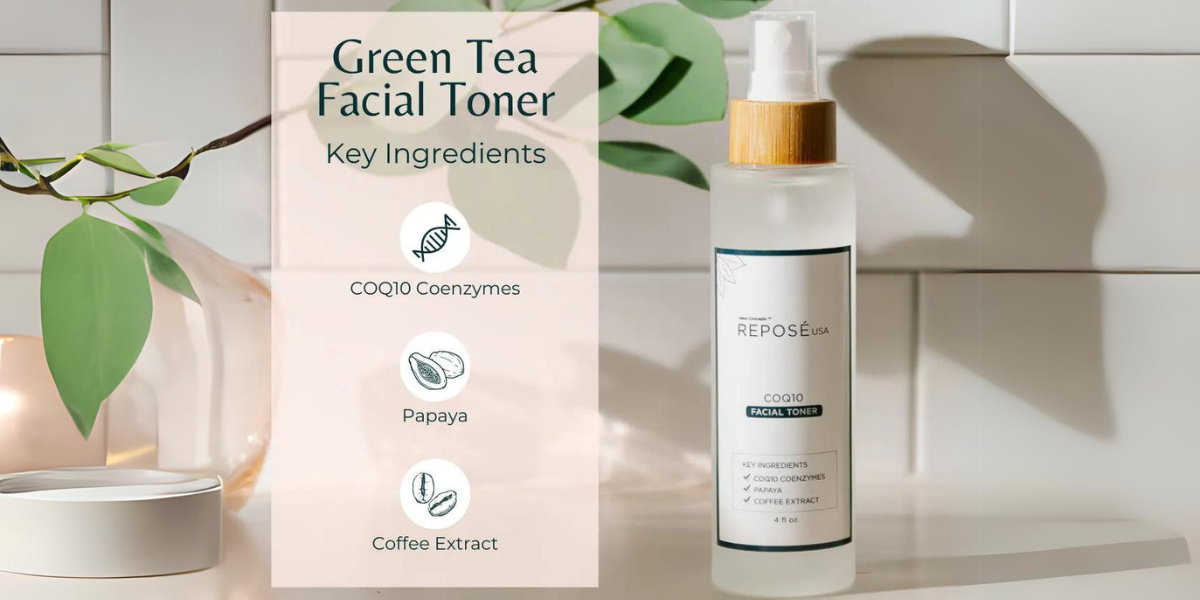Key Takeaways:
- Optimal pH Range: Discover why the skin’s normal pH falls between 4.7 and 5.75, and how this balance supports skin health.
- Factors That Disrupt pH: Understand the various internal and external factors that can cause pH imbalances, such as cleansers and environmental elements.
- Maintaining pH Balance: Learn actionable tips and product recommendations for keeping your skin’s pH balanced and healthy.
What if the secret to healthy, glowing skin lies in something as simple as your skin’s pH balance? Many skincare enthusiasts are unaware that an imbalanced pH can lead to dryness, breakouts, and premature aging. At Reposé, we pride ourselves on delivering scientifically backed skincare solutions. Our expertise lies in crafting products like the CoQ10 Hydrating Facial Toner, specifically designed to restore and maintain your skin’s natural pH balance.
In this piece, we will discuss the normal pH range of the skin and how to keep it balanced for optimal health.
What Is The Normal pH Range Of The Skin?
The pH of the skin plays a crucial role in maintaining its health and protecting against external irritants. The normal pH range of the skin typically falls between 4.7 and 5.75, which is slightly acidic. This acidity, often referred to as the “acid mantle,” helps the skin ward off harmful bacteria, fungi, and other environmental aggressors. It also ensures that the skin’s natural barrier functions properly, keeping it hydrated and resilient.
Understanding the normal pH range of the skin is essential because even slight deviations from this range can lead to various skin issues, such as dryness, irritation, or acne. Maintaining this balance is critical for overall skin health and appearance.
Ready to bring your skin’s pH back into balance and achieve a radiant, hydrated complexion? Our CoQ10 Hydrating Facial Toner is expertly formulated to restore your skin’s natural acidity while deeply nourishing and refreshing. Don’t let an imbalanced pH stand in the way of healthy skin—make the switch to a product designed with science and care. Visit Reposé today to explore how our pH-balancing toner can transform your skincare routine.
Why Is The Skin’s pH Important?
The skin’s pH is more than just a number; it reflects the balance that ensures the skin remains healthy, protected, and functioning optimally. When the pH balance is within the normal range, your skin is equipped to defend against harmful elements and retain moisture. Below are the top five reasons why maintaining the skin’s pH is crucial for overall skin health:
Protects Against Harmful Microbes
The skin’s slightly acidic pH creates an environment that is hostile to harmful bacteria, fungi, and viruses. This helps prevent infections and breakouts, as the acid mantle acts as a first line of defense against pathogens. When the pH level is disrupted, the skin becomes more susceptible to infections and inflammation.
Maintains The Skin’s Barrier Function
The pH plays a significant role in preserving the integrity of the skin’s natural barrier, known as the stratum corneum. This barrier helps lock in moisture and protect against external pollutants. A balanced pH ensures that the skin barrier stays intact, keeping your skin hydrated and resilient.
Supports Natural Exfoliation
The skin’s pH assists in the natural shedding of dead skin cells through a process called desquamation. A slightly acidic pH optimizes this process, preventing clogged pores and dull skin. Disruption in pH can lead to buildup, which may result in rough, flaky skin or acne.
Enhances The Effectiveness Of Skincare Products
Many skincare products are formulated to work best when the skin is in its natural acidic state. When the skin’s pH is balanced, these products can penetrate deeper and deliver better results. If the pH is too high or too low, it can neutralize the efficacy of these products, leading to poor results.
Prevents Premature Aging
An optimal pH level contributes to maintaining skin firmness and elasticity. A balanced pH helps protect collagen, the protein responsible for keeping skin youthful. When the pH is too alkaline, the skin may become dehydrated, accelerating the signs of aging such as wrinkles and sagging.
Factors Affecting The Skin’s pH Balance
Various internal and external factors can influence the skin’s pH balance, disrupting its natural defenses and leading to skin problems. Being aware of these factors is essential in maintaining a healthy, well-balanced pH level. Below are five of the most significant factors that can impact the skin’s pH:
Cleansers And Soaps
Many traditional cleansers and soaps are formulated with a higher pH, making them too alkaline for the skin. This can strip away the natural oils and damage the acid mantle, leading to dryness, irritation, and breakouts. It’s important to choose pH-balanced cleansers that respect the skin’s natural acidity.
Environmental Factors
External environmental conditions such as pollution, harsh weather, and UV radiation can disrupt the skin’s pH balance. Pollution particles can interfere with the acid mantle, making it difficult for the skin to maintain its protective functions. Additionally, prolonged sun exposure without proper protection can alter the pH, leading to increased sensitivity and damage.
Diet And Hydration
What you eat and drink can also have a significant effect on your skin’s pH. A diet high in processed foods, sugar, and dairy can increase acidity in the body, which may reflect on the skin. Staying hydrated and consuming a balanced diet rich in vitamins and antioxidants helps support your skin’s natural pH levels.
Skincare Products And Treatments
The use of harsh exfoliants, toners, and other skincare treatments that are not pH-appropriate can throw off the skin’s delicate balance. Products with alcohol, fragrances, or strong acids can increase alkalinity or make the skin too acidic, disrupting its protective barrier. Opting for pH-balanced products is key to preventing long-term skin damage.
Age And Hormonal Changes
As we age, the skin’s pH naturally becomes more alkaline, which can weaken the skin barrier and lead to dryness, wrinkles, and other signs of aging. Hormonal changes, such as those during puberty, pregnancy, or menopause, can also affect the skin’s pH, making it more prone to issues like acne or sensitivity.
How To Maintain A Healthy Skin pH?
Maintaining a healthy skin pH is essential for keeping your skin looking vibrant, balanced, and free from irritation. There are several simple yet effective ways to ensure your skin remains within its optimal pH range. Below are five key practices to help you maintain a healthy skin pH:
Use pH-Balanced Skincare Products
Opt for cleansers, moisturizers, and toners that are specifically formulated to be pH-balanced. Products with a pH between 4.7 and 5.5 are ideal, as they align with the skin’s natural acidity. This helps protect the acid mantle, preventing disruption to your skin’s barrier while allowing skincare products to work more effectively.
Avoid Over-Washing
Washing your face too often can strip the skin of its natural oils and disturb its pH balance. Even with pH-balanced cleansers, over-cleansing can lead to dryness and irritation. Stick to washing your face twice a day—once in the morning and once at night—to maintain healthy skin without causing pH imbalances.
Incorporate Hydrating Ingredients
Ingredients like hyaluronic acid, glycerin, and ceramides help to maintain the skin’s moisture barrier, which is vital for pH balance. Hydration keeps the skin supple and resilient, reducing the likelihood of pH disruption caused by dryness or environmental factors. Regularly using a hydrating moisturizer can help stabilize your skin’s pH.
Use Sun Protection Daily
UV rays can compromise the skin’s natural pH by damaging its outermost layer, leading to a breakdown in barrier function. Applying a broad-spectrum sunscreen with at least SPF 30 every day is crucial to maintaining a balanced skin pH. This protects against sun damage while preserving the skin’s natural acidity.
Monitor Your Diet And Lifestyle
Eating a balanced diet rich in fruits, vegetables, and omega-3 fatty acids can help regulate your skin’s pH from within. Avoiding excessive sugar, caffeine, and processed foods is equally important, as these can trigger inflammation and affect skin health. Additionally, managing stress through relaxation techniques or exercise can also support skin’s natural pH balance.
Signs Of An Imbalanced Skin pH
An imbalanced skin pH can lead to a variety of skin issues, making it important to recognize the warning signs early on. When the pH of your skin is either too acidic or too alkaline, its protective functions weaken, leaving it vulnerable to damage. Below are the top five signs that indicate your skin’s pH may be out of balance:
- Dryness And Flakiness: If your skin feels unusually dry or starts to peel and flake, it could be a sign that your pH is too alkaline. Excessive dryness occurs when the acid mantle is compromised, leading to moisture loss and a weakened skin barrier.
- Increased Sensitivity: A disrupted pH balance can make your skin more reactive to skincare products, environmental factors, or even fabrics. If you notice redness, itching, or irritation after using your usual skincare products, your skin’s pH might be off.
- Frequent Breakouts: Skin that is too alkaline creates a more favorable environment for harmful bacteria, which can cause breakouts and acne. If you are experiencing more breakouts than usual, especially if they occur without changes in diet or skincare routine, your pH could be the culprit.
- Oily Or Shiny Skin: An overly acidic pH can stimulate the overproduction of sebum, causing your skin to appear greasy and shiny. This excess oil can clog pores and lead to more breakouts or blackheads over time if not addressed.
- Dull And Uneven Skin Tone: When the pH is not balanced, the natural exfoliation process slows down, leading to a buildup of dead skin cells. This results in a dull, uneven complexion, making your skin look tired and lackluster despite your efforts to care for it.
Being mindful of these signs can help you quickly identify when your skin’s pH is imbalanced, allowing you to take steps to restore its natural health and vitality.
The Role Of Skincare Products In Regulating Skin pH
Skincare products play a critical role in maintaining and regulating the skin’s pH balance. Using the right products can support your skin’s natural acidity, while the wrong ones can disrupt it, leading to various skin issues. Below are the top five ways skincare products influence the skin’s pH and what you should consider when choosing them:
Cleansers With High pH
Many traditional soap-based cleansers have a pH that is too high (alkaline) for the skin, which can strip away its natural oils and disrupt the acid mantle. This leaves the skin vulnerable to bacteria and external irritants, leading to dryness and irritation. Switching to a pH-balanced cleanser is crucial for maintaining the skin’s health.
Toners That Restore pH Balance
After cleansing, toners formulated to balance the skin’s pH can help neutralize any remaining alkalinity. These toners, especially those with soothing and hydrating ingredients, can restore the skin to its ideal acidic state, enhancing its protective barrier. Using toners regularly ensures the skin maintains its optimal pH after cleansing.
Moisturizers That Support The Skin Barrier
Moisturizers containing ceramides, fatty acids, and other barrier-supporting ingredients help keep the skin’s pH stable. They lock in moisture and prevent the skin from becoming too dry or oily, both of which can lead to imbalances. A good moisturizer ensures that your skin’s protective barrier remains intact and its pH remains within a healthy range.
Exfoliants And Acids
Chemical exfoliants like alpha hydroxy acids (AHAs) and beta hydroxy acids (BHAs) are designed to work with the skin’s natural pH. These acids, when used correctly, can regulate pH by encouraging healthy cell turnover and preventing buildup that could otherwise disrupt the skin’s balance. However, overuse or misuse of these acids can tip the pH too far toward acidity, leading to irritation.
pH-Optimized Sunscreens
Sunscreens not only protect your skin from harmful UV rays but also help maintain a balanced pH when formulated correctly. Physical sunscreens with ingredients like zinc oxide and titanium dioxide often have pH levels that align with the skin’s natural state. Applying sunscreen daily prevents sun damage, which can throw off the skin’s pH, ensuring long-term balance.
Why CoQ10 Hydrating Facial Toner Is A Great pH Balance Helper
The CoQ10 Hydrating Facial Toner is specifically formulated to help restore and maintain your skin’s pH balance. Here’s how it supports a healthy pH:
- pH-Balanced Formula: Designed to work in harmony with the skin’s natural acidity, ensuring the skin remains protected and hydrated.
- Antioxidant Power: CoQ10 helps neutralize environmental stressors that can disrupt pH.
- Hydration Boost: Moisturizing ingredients prevent dryness, a common symptom of imbalanced pH.
- Gentle and Effective: Suitable for all skin types, including sensitive skin, it nourishes without irritation.
The CoQ10 Hydrating Facial Toner is an essential step in any skincare routine, ensuring balanced, healthy, and radiant skin.
Final Thoughts
Understanding and maintaining the skin’s natural pH is a critical component of achieving healthy, resilient skin. By keeping your pH within its optimal range, you protect your skin from common issues like dryness, sensitivity, and breakouts. Armed with the right knowledge and the right skincare products, such as those offered by Reposé, you can ensure that your skin remains balanced, glowing, and well-protected. Taking the necessary steps to monitor and regulate your skin’s pH will lead to long-term benefits in both appearance and overall skin health.
Read Also:
- How To Choose The Right Hydrating Toner For Every Skin Type
- The Best Facial Toner For Aging Skin
- What Is Facial Toner And How Can It Transform Your Skin?
Frequently Asked Questions About What Is The Normal pH Range Of the Skin
What Does Skin pH Mean?
Skin pH refers to how acidic or alkaline the skin is. It’s measured on a scale from 0 (most acidic) to 14 (most alkaline), with the normal range for healthy skin being slightly acidic, between 4.7 and 5.75.
How Can I Test My Skin’s pH at Home?
You can test your skin’s pH using pH strips specifically designed for skin, available at most beauty stores. Gently press the strip onto a clean area of your face and compare the results to the pH chart provided with the product.
Can Skin pH Vary Across Different Parts of the Body?
Yes, the skin pH can vary slightly in different areas. For instance, areas like the forehead and chest may have a slightly more acidic pH compared to less exposed areas like the arms or legs.
How Long Does It Take to Restore Skin’s pH After Disruption?
It can take anywhere from a few hours to a few days to restore skin’s pH, depending on the severity of the disruption. Using pH-balanced products can speed up this process significantly.
Does Drinking Water Help Balance Skin pH?
While drinking water is essential for overall health, it doesn’t directly affect the skin’s pH. However, staying hydrated supports the skin’s ability to retain moisture and maintain a healthy barrier, which indirectly helps maintain pH balance.
Can pH Imbalance Lead to Long-Term Skin Damage?
Yes, chronic pH imbalance can lead to long-term skin issues like persistent dryness, breakouts, and premature aging. Over time, a disrupted pH weakens the skin barrier, making it less able to defend against environmental aggressors.
Sources:
- Skotnicki, S. (2020). Skin pH, Epidermal Barrier Function, Cleansers, and Skin Health. Updates in Clinical Dermatology, 5–12. https://doi.org/10.1007/978-3-030-28872-3_2
- Lukić, M., Pantelić, I., & Savić, S. D. (2021). Towards Optimal pH of the Skin and Topical Formulations: From the Current State of the Art to Tailored Products. Cosmetics, 8(3), 69. https://doi.org/10.3390/cosmetics8030069
- Firooz, A., Gorouhi, F., Davari, P., Atarod, M., Hekmat, S., Rashighi-Firoozabadi, M., & Solhpour, A. (2007). Comparison of hydration, sebum and pH values in clinically normal skin of patients with atopic dermatitis and healthy controls. Clinical and Experimental Dermatology, 32(3), 321–322. https://doi.org/10.1111/j.1365-2230.2007.02364.x










